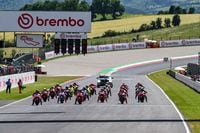We’ve already had a glimpse of Honda’s upcoming Transalp 750 thanks to a patent application. Now that’s been joined by additional patent documents giving a closer look at elements including the front fairing and air intakes.
Honda is expected to take the wraps off the new Transalp at the EICMA show in Milan next month, although whether it’ll be a 2023 production model or an early showing of a 2024 bike remains to be seen. What we do know is that it’s closely related to the new CB750 Hornet and shares the same new 755cc parallel-twin engine, which is good for 90.5 hp in the 2023 Hornet, and also uses a similar steel frame. Those shared parts imply that the Transalp will be aimed at offering a Ténéré 700–beating spec at a lower price, just as the Hornet’s price in Europe manages to undercut Yamaha’s MT-07 despite having nearly 20 additional horsepower and higher-specification suspension, brakes, and electronics
Word of Honda’s plan for a new Transalp and the related Hornet emerged more than a year ago. Details we heard back then, including that the engine would displace 755cc, have proved accurate. Honda filed trademark applications for both the Hornet and Transalp names back then, and it’s worth noting that while there has been no attempt to register the Hornet name in the US, Honda is undergoing the process to protect the Transalp name in the States at the moment, essentially confirming it intends to offer the adventure model here.
The new patents are interesting because there’s a specific focus on the Transalp’s fairing and air intake, which means the images in the patent documents have to be fairly accurate representations of the bike’s actual appearance. The documents show that the fairing’s side panels have separate inner and outer skins, with air intakes on the leading edge of each side just above the front wheel. The outer panels give a clean look to the bike’s sides, while the inner ones are molded to direct air from just below the headlight into the airbox, first turning it down and then pulling it in toward the middle of the bike, above the cylinder head where the airbox sits. The lower sections of the side panels direct air into the radiator, which is a single, conventionally placed unit behind the front wheel rather than the twin side-mounted layout that’s used on the Africa Twin.
Higher up, the headlight appears to be shared with the Hornet, which itself borrows its lamp from the existing CB500F to help keep costs down, while the patents also show that the Transalp has an unusual position for the radiator expansion tank, which is mounted low down at the back of the engine, just below the swingarm pivot. A pipe runs up from the expansion tank, ending with a cap just above the clutch cover that’s used to top up the coolant. Since the Transalp is likely to be revealed at EICMA in November, we shouldn’t have long to wait before these details are confirmed, along with Honda’s plans for the bike, which will hopefully include plans to offer it in the US.
/cloudfront-us-east-1.images.arcpublishing.com/octane/WPMTTPO67BCV5HCMRFZI4WX3BU.jpg)
/cloudfront-us-east-1.images.arcpublishing.com/octane/INVCZYDXR5H7XMT3YASCVPCTMI.jpg)
/cloudfront-us-east-1.images.arcpublishing.com/octane/6W5CLMS43RD55AUBQFA326V3PE.jpg)
/cloudfront-us-east-1.images.arcpublishing.com/octane/DS3Q5X2VJFFAJDK2PWB3Y7K6U4.jpg)
/cloudfront-us-east-1.images.arcpublishing.com/octane/4KBL4JAMYRFDPEINTWATDUH7OM.jpg)
/cloudfront-us-east-1.images.arcpublishing.com/octane/FXADK3MVSNBRTKJ2B7TPDCCJ5Y.jpg)
/cloudfront-us-east-1.images.arcpublishing.com/octane/M7L2CPXO55FRFMECW7QGDPGP6E.jpg)
/cloudfront-us-east-1.images.arcpublishing.com/octane/T4RWGLAEHVE2VCJZOTFTNGB2KA.jpg)
/cloudfront-us-east-1.images.arcpublishing.com/octane/JM4QGLAHWNGHPM74OEB7FVBFSY.jpg)
/cloudfront-us-east-1.images.arcpublishing.com/octane/BGPNXPDDYBHD3HL6YEZQOYHXTI.jpg)
/cloudfront-us-east-1.images.arcpublishing.com/octane/SND5GGQV4RDPPMZBSBEGIZ4SIY.jpg)
/cloudfront-us-east-1.images.arcpublishing.com/octane/XUDDAPYZMZEL5EDPVDJ2DTULWI.jpg)
/cloudfront-us-east-1.images.arcpublishing.com/octane/M7AU2L6GAVCJVHW57LIRPDAAUQ.jpg)

/cloudfront-us-east-1.images.arcpublishing.com/octane/JKEJY7P43JGD5C5NJO2VJQJPUM.jpg)
/cloudfront-us-east-1.images.arcpublishing.com/octane/YROKYJYUQVGPHCEMPTGBWDQCKQ.jpg)
/cloudfront-us-east-1.images.arcpublishing.com/octane/QIHEYR66TZDAPCGMWHCWCBC4XA.jpg)
/cloudfront-us-east-1.images.arcpublishing.com/octane/4FTBMNZL5BD2ZHY62XXRHJW6PI.jpg)
/cloudfront-us-east-1.images.arcpublishing.com/octane/L2BHKRCEMFDF7O3S4REZXPDH2E.jpg)
/cloudfront-us-east-1.images.arcpublishing.com/octane/QHENIV3HMJCTTCXQ6O5YPTNRZ4.jpg)
/cloudfront-us-east-1.images.arcpublishing.com/octane/K3VNQBIAKVGIHIGBRG7QKJYLVI.jpg)
/cloudfront-us-east-1.images.arcpublishing.com/octane/HRU64QXT3NH2DJOFBVI53XIKCE.jpg)
/cloudfront-us-east-1.images.arcpublishing.com/octane/4C5HHSNJCVDZXPIJTCJBVTE2MU.jpg)
/cloudfront-us-east-1.images.arcpublishing.com/octane/HBKK2TCOCZFIBIVKLKZFF5NXLQ.jpg)
/cloudfront-us-east-1.images.arcpublishing.com/octane/23S5ZEY2FBBADHQQK7AKLFDNYM.jpg)
/cloudfront-us-east-1.images.arcpublishing.com/octane/OPF3CNKKLVAN3AHQWD22DPWLEQ.jpg)
